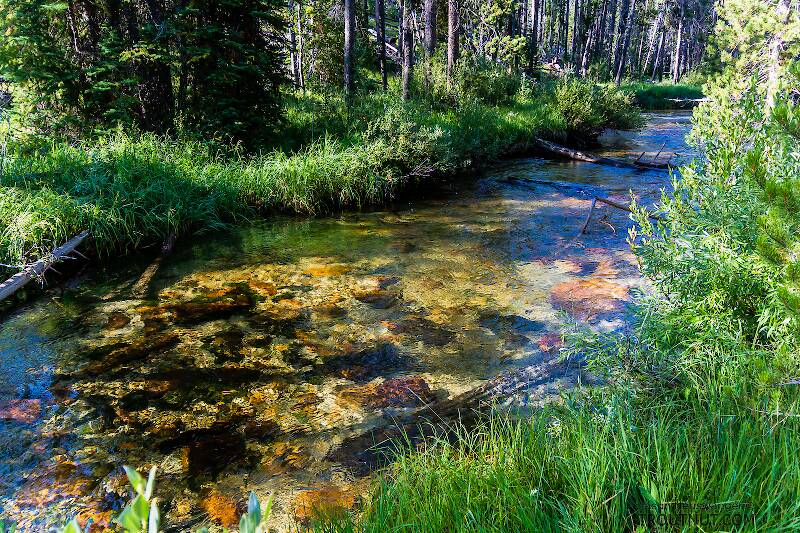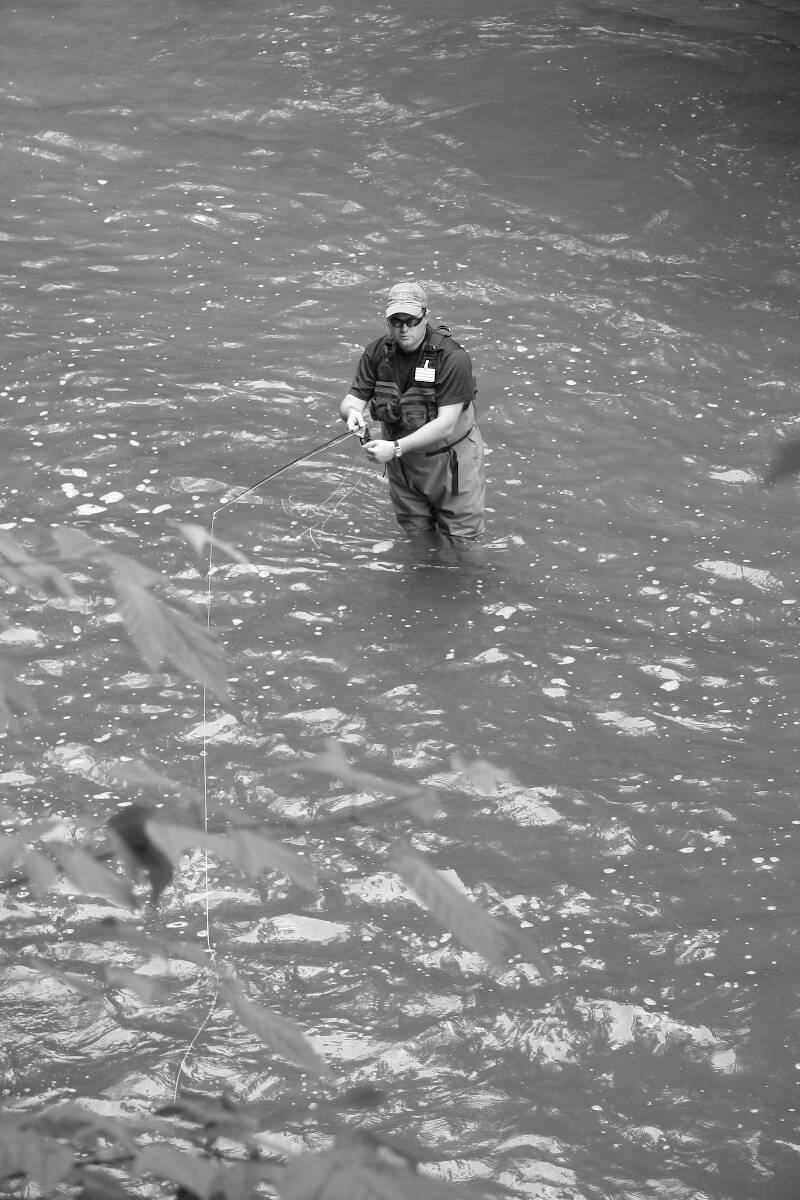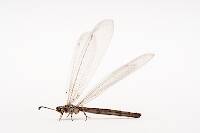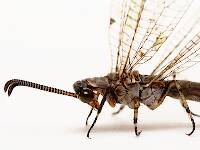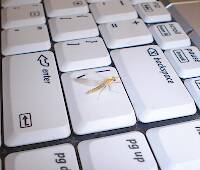
Blue-winged Olives
Baetis
Tiny Baetis mayflies are perhaps the most commonly encountered and imitated by anglers on all American trout streams due to their great abundance, widespread distribution, and trout-friendly emergence habits.
Featured on the forum

This wild-looking little thing completely puzzled me. At first I was thinking beetle or month larva, until I got a look at the pictures on the computer screen. I made a couple of incorrect guesses before entomologist Greg Courtney pointed me in the right direction with Psychodidae. He suggested a possible genus of Thornburghiella, but could not rule out some other members of the tribe Pericomini.

Troutnut is a project started in 2003 by salmonid ecologist Jason "Troutnut" Neuswanger to help anglers and
fly tyers unabashedly embrace the entomological side of the sport. Learn more about Troutnut or
support the project for an enhanced experience here.
Chillmark
Posts: 3
Posts: 3
Chillmark on Apr 11, 2009April 11th, 2009, 3:46 am EDT
So the title may sound odd, but hear me out. I'm somewhat new to the sport; I've been fishing a dozen times a year for the past 3 years or so now. I do OK, catching the occasional fish, but mostly I just enjoy being out there. There is one thing, however, that continues to irk me. I check online, or at the local fly shops for what's biting, and the answer I get usually makes no sense. That is to say, I find the names given to flies (and I use the term flies in the artificial sense, not the biological versions) to be completely and utterly perplexing. "they're bitin' on royal wolfs, parachutes, hairs ear and hassenflappers..."
Huh?!?
So say I have a fly sitting in front of me. I've just bought it from the store and I've no idea what it is. Is there a way to identify flies? The artificial ones, of course...the ones with hooks?
I went through my fly box last night and there's a couple in there that I can't tell if they should be fished dry or wet for instance. If there was some sort of cheat sheet however, I would know. Does this sort of thing exist?
Help a brutha' out, pu-LEASE!
Thanks!
Huh?!?
So say I have a fly sitting in front of me. I've just bought it from the store and I've no idea what it is. Is there a way to identify flies? The artificial ones, of course...the ones with hooks?
I went through my fly box last night and there's a couple in there that I can't tell if they should be fished dry or wet for instance. If there was some sort of cheat sheet however, I would know. Does this sort of thing exist?
Help a brutha' out, pu-LEASE!
Thanks!
Taxon on Apr 11, 2009April 11th, 2009, 4:47 am EDT
Chillmark-
Interesting question. Several thoughts come to mind. Looking forward, you would be well-served to make sure when you purchase flies in a fly shop, that you write down the name of the pattern when purchasing. Of course, that doesn't help you much in the case of flies which you have already purchased. If you normally purchase flies at one particular fly shop, you could always re-visit that shop, and ask what they are called. However, the more satisfying solution would probably be to just learn more about fly patterns and flies they imitate. On the other hand, if you were to take a photo of a fly pattern about which you are confused, and post it on this forum, I'm sure someone will tell you what it is, and what it imitates, and how to fish it.
Interesting question. Several thoughts come to mind. Looking forward, you would be well-served to make sure when you purchase flies in a fly shop, that you write down the name of the pattern when purchasing. Of course, that doesn't help you much in the case of flies which you have already purchased. If you normally purchase flies at one particular fly shop, you could always re-visit that shop, and ask what they are called. However, the more satisfying solution would probably be to just learn more about fly patterns and flies they imitate. On the other hand, if you were to take a photo of a fly pattern about which you are confused, and post it on this forum, I'm sure someone will tell you what it is, and what it imitates, and how to fish it.
Shawnny3 on Apr 11, 2009April 11th, 2009, 6:57 am EDT
I agree with Taxon. Another thing that might be instructive for you would be to get your hands on a basic book of fly patterns (no need to buy it, necessarily - that's what libraries are for). There are lots of these out there - Dave Hughes's book Essential Trout Flies covers most of the standard patterns you'd be likely to find in a flyshop, and has descriptions of how they're tied and a few ideas about how to fish them. There are many others, but that one comes immediately to mind and is not expensive. It's also not a bad place to start if you want to begin tying a few yourself. But take care - tying a few flies to save money at the flyshop is a little like spending your money on a few hits of heroin so that you don't spend so much money on cigarettes.
-Shawn
-Shawn
Jewelry-Quality Artistic Salmon Flies, by Shawn Davis
www.davisflydesigns.com
www.davisflydesigns.com
Wbranch on Apr 12, 2009April 12th, 2009, 12:14 am EDT
Here are two paperback fly identification books that have great color photos of hundreds of trout flies. Wet flies, nymphs, emergers, dry flies, spinners, streamers, and whatever I omitted.
Flies for Trout by Dick Stewart and Farrow Allen
Fly Patterns of Umpqua Feather Merchants by Randall Kaufmann
Flies for Trout by Dick Stewart and Farrow Allen
Fly Patterns of Umpqua Feather Merchants by Randall Kaufmann
Catskill fly fisher for fifty-five years.
Hellgramite on Apr 12, 2009April 12th, 2009, 7:34 am EDT
Hey Chillmack:I had the same problem when I started Fly Fishing and after spending some time with guides I found that there are Three main bugs that hatch in almost every water around the country.There is the Mayfly,The Caddisfly,And the Stonefly.Where you get confused is every tier ties the same bug but gives it a name of there own.The first thing you need to do is learn the basics.Depending where you fish the insects can be size 22,20,18 and so on.They can be Green,Pale blue,Tan,Brown ect.Where I fish In Calif.The Mayfly's are size 24 to 18 and are Green to Pale blue.The Caddisflies are size 20 to 18 and are Tan,Gray,and Brown.There are very few Stoneflies unless you head up north. I will be moving to Central Oregon in June and there are the same insects in Oregon but they are size 18 to 14 and there are Stoneflies in size 14 to 8.A Mayfly's wings are upright and a Caddisflies wings are down on its back and the same with a Stonefly.So if you learn those three basic insects you will have a better understanding about what to use.A parachute is a high vis thread that is tied to the top of a small dryfly size 24 to say 18 and it helps you to see the fly on the water.Another thing I did was to go to the local fly shop and talk to the guy's that work there and ask a ton of questions.You can also go online to some websites where they sell flies and just look at all the fly's they offer.A nymph is the insect in its larva stage which is about 90% of a Trouts diet.So unless there is a hatch in progress you will be fishing a nymph most of the time.For Each insect there is an artificial nymph in different colors and different sizes.They have regular nymph's and there are bead head's.Bead head nymph's are tied with a bead at the top of the hook to help add weight.There are weighted nymph's that are tied with lead wire wrapped around the hook shank before it is tied to add weight.I could go on for ever about this.So start with these three bugs and the rest will come to you in time Good Luck and I hope I have helped.
DOS on Apr 12, 2009April 12th, 2009, 9:35 am EDT
"Flies for Trout by Dick Stewart and Farrow Allen"
Matt great recommendation!
This is one of the first fly fishing books I got as a kid and still refer to it today!!
Matt great recommendation!
This is one of the first fly fishing books I got as a kid and still refer to it today!!
Andrew Nisbet
Chillmark
Posts: 3
Posts: 3
Chillmark on Apr 12, 2009April 12th, 2009, 12:01 pm EDT
Criminey!
That on Umpaqua book is $500!
And not in my local library!
But thanks for all the input. I do have Dave Hughes' Handbook of Hatches, but I was hoping for something more digested. I'm going to look into the books you've all noted and talk to the guys at my local fly shop tomorrow.
thanks!
That on Umpaqua book is $500!
And not in my local library!
But thanks for all the input. I do have Dave Hughes' Handbook of Hatches, but I was hoping for something more digested. I'm going to look into the books you've all noted and talk to the guys at my local fly shop tomorrow.
thanks!
Patcrisci on Apr 17, 2009April 17th, 2009, 6:02 am EDT
Eric Leiser's Book of FLy Patterns has great color plates of artificials and hundreds of fly patterns. It's a valuable reference.
Pat Crisci
Flatstick96 on Apr 17, 2009April 17th, 2009, 11:48 am EDT
If you find an expensive or rare book that you want to look at, but which isn't available at your local library, they can usually get it for you on "loan" from other libraries around the country - it usually takes a few weeks, but it's better than nothing...
GONZO on Apr 17, 2009April 17th, 2009, 2:00 pm EDT
Chillmark,
Although I should probably be the last person to discourage you from buying (or borrowing) books, it seems that a simple and inexpensive solution might be to go to Umpqua's website and scan through the categories of flies to see if you can find any matches:
http://www.umpqua.com/t-flygallery.aspx
Although I should probably be the last person to discourage you from buying (or borrowing) books, it seems that a simple and inexpensive solution might be to go to Umpqua's website and scan through the categories of flies to see if you can find any matches:
http://www.umpqua.com/t-flygallery.aspx
Peregrines
Posts: 2
Posts: 2
Peregrines on Apr 28, 2009April 28th, 2009, 4:51 am EDT
This is a great question. One way to start is to brows and site like the Umpqua link, or the online catalog of places like Orvis, just to get an idea of what different flies look like. The names can be very confusing but a good place to start would be to learn the difference between different broad categories of flies and some popular patterns that give a good representation of different styles:
Dry Flies, traditionally tied with a stiff hackle collar wound around the hook like an airplane propeller (examples Hendrickson, Adams, Blue Winged Olive) but now also tied with hackle wound around the wing like a helicopter (Parachute Adams, Parachute Blue Winged Olive Etc), without hackle using splayed deer hair wings (Blue Winged Olive Comparadun, Sulphur Sparkledun etc.) or Cul De Canard (CDC Blue Winged Olive) for flotation. There are also several styles of flies like heavily hackled Wulff’s, Humpies etc that are good attractor patterns in fast water. Typically mayfly patterns are tied with upright wings, or “spent wings” for spinner patterns (Rusty Spinner) that imitate the adult stage of the mayfly. Caddis and stonefly imitations are tied with “down wings” (Elk Hair Caddis, Fluttering Caddis, Stimulator). Once you have a sense of the different styles of flies you can mix different styles of flies in the size and color scheme to match the naturals using th pics here on troutnut.
Wet flies- traditionally have soft (rather than stiff) hackle that flows back to the hook point. Typical patterns would be “soft hackles” (Partridge and Orange), Quill Gordon Wet) and more modern patterns like Emergent Sparkle Pupae.
Nymphs- pretty obvious, but take a look at stonefly nymphs (Kaufmann’s Stone) vs mayfly nymphs (Pheasant Tail Nymph, Gold Ribbed Hare’s Ear) vs Caddis larvae (Green Rock Worm, Peeking Caddis) vs Midge larvae and pupae (Zebra Midge)
Emergers- often look like a nymph with a wing of some sort and are typically designed to float in the film- (CDC emrger)
Streamers- can be made with feather wings (Black Ghost), bucktail (Black Nosed Dace. Mickey Finn), and spun deer hair heads (Muddler Minnow), rabbit strips (Zonker) and marabou (Wooly Bugger, marabou muddler)
Hope this helps a bit.
mark
Dry Flies, traditionally tied with a stiff hackle collar wound around the hook like an airplane propeller (examples Hendrickson, Adams, Blue Winged Olive) but now also tied with hackle wound around the wing like a helicopter (Parachute Adams, Parachute Blue Winged Olive Etc), without hackle using splayed deer hair wings (Blue Winged Olive Comparadun, Sulphur Sparkledun etc.) or Cul De Canard (CDC Blue Winged Olive) for flotation. There are also several styles of flies like heavily hackled Wulff’s, Humpies etc that are good attractor patterns in fast water. Typically mayfly patterns are tied with upright wings, or “spent wings” for spinner patterns (Rusty Spinner) that imitate the adult stage of the mayfly. Caddis and stonefly imitations are tied with “down wings” (Elk Hair Caddis, Fluttering Caddis, Stimulator). Once you have a sense of the different styles of flies you can mix different styles of flies in the size and color scheme to match the naturals using th pics here on troutnut.
Wet flies- traditionally have soft (rather than stiff) hackle that flows back to the hook point. Typical patterns would be “soft hackles” (Partridge and Orange), Quill Gordon Wet) and more modern patterns like Emergent Sparkle Pupae.
Nymphs- pretty obvious, but take a look at stonefly nymphs (Kaufmann’s Stone) vs mayfly nymphs (Pheasant Tail Nymph, Gold Ribbed Hare’s Ear) vs Caddis larvae (Green Rock Worm, Peeking Caddis) vs Midge larvae and pupae (Zebra Midge)
Emergers- often look like a nymph with a wing of some sort and are typically designed to float in the film- (CDC emrger)
Streamers- can be made with feather wings (Black Ghost), bucktail (Black Nosed Dace. Mickey Finn), and spun deer hair heads (Muddler Minnow), rabbit strips (Zonker) and marabou (Wooly Bugger, marabou muddler)
Hope this helps a bit.
mark
DSFlyman
Posts: 13
Posts: 13
DSFlyman on Apr 28, 2009April 28th, 2009, 2:41 pm EDT
Brutha, I feel your pain - there are a lot of books and online resources that might help you out. This is not intended to be a shameless plug, but I've tried on my website to match tied flies to their real life insect cousins. I figured down the road someone might want that info. It covers the basics, but from the basics comes all those variations.
DS Flyman
www.dsflyfishing.com
DSFlyfishing
www.dsflyfishing.com
DSFlyfishing
Macalistair on Oct 29, 2013October 29th, 2013, 12:26 pm EDT
i have been having the same problems as you chillmark but i have found a good website!!
http://www.fliesonline.co.uk/
http://www.fliesonline.co.uk/
Quick Reply
Related Discussions
Topic
Replies
Last Reply
6
Nov 4, 2011
by Dinerobyn
by Dinerobyn
Re: Identification of a possible Cordulegaster Dragonfly Nymph
In Cordulegaster Dragonfly Nymph by IanB
In Cordulegaster Dragonfly Nymph by IanB
6
Feb 10, 2017
by Taxon
by Taxon
1
Oct 24, 2008
by Brookyman
by Brookyman

